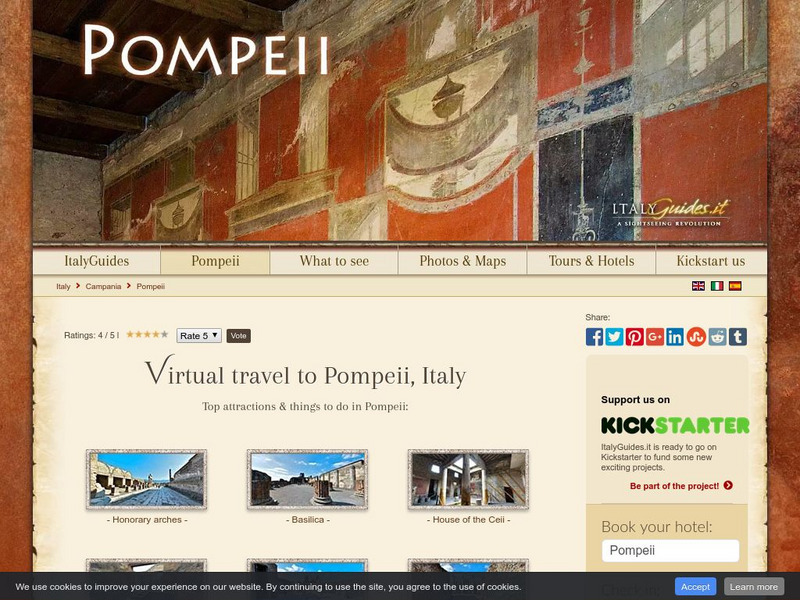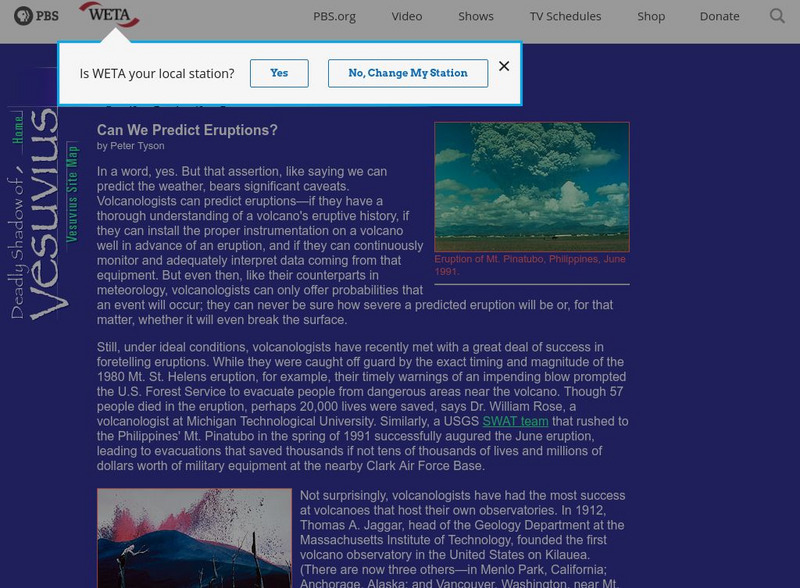Science Struck
Science Struck: Facts About Mount Vesuvius
Read about the geology and history of Mount Vesuvius in Italy, how it was formed, its destruction of Pompeii and Herculaneum in AD 79, the next eruption in 1944, and what it is like today.
United Nations
Unesco: Archaeological Areas of Pompei, Herculaneum and Torre Annunziata
This World Heritage website looks at the Roman towns of Pompeii and Herculaneum, and wall paintings at Torre Annunziata, that were buried when Mount Vesuvius erupted in 79 AD. Found here are a description, news, maps, documentation,...
Other
Herculaneum Conservation Project: Herculaneum Panoramas
A virtual tour of Herculaneum, one of the towns destroyed when Mount Vesuvius erupted in 79 AD. Click on the blue dots on the map, or the tabs on the left to access the virtual tour of the excavated site.
Google
Google Maps: Interactive Tour: Pompei
An interactive tour of the excavated remains of the ancient Roman city of Pompeii, which was destroyed by the eruption of Mount Vesuvius in 79 AD.
Australian Broadcasting Corporation
Australian Broadcasting Corporation: News in Science: Vesuvius (World's Most Dangerous Volcano)
An article outlines the reasons why Vesuvius should be considered the world's most dangerous volcano.
Other
Italy Guides: Virtual Travel to Pompeii, Italy
Explore the city of Pompeii in this virtual tour. Houses, temples, baths, arches, and other structures are all on display. The history of Pompeii is explained, and each interactive structure is accompanied by a description. The different...
Curated OER
Web Gallery of Art: View of the Eruption of Mount Vesuvius
An image of "View of the Eruption of Mount Vesuvius", created by Pierre-Jacques Volaire during the 1770's (Oil on canvas, 56 x 76 cm).
Science Education Resource Center at Carleton College
Serc: Eruption!
A downloadable computer simulation which showcases a series of villages that surround an active volcano. The volcano is modeled after Mount Vesuvius and is getting close to erupting. The goal of the exercise is to preserve as many people...
Houghton Mifflin Harcourt
Harcourt: School Publishers: Unraveling Ancient Mysteries: Pompeii
Harcourt School reveals the background to the 79 C.E. eruption of Mt. Vesuvius and the destruction of the Roman city of Pompeii and nearby Herculaneum. Features include animations of the eruption, pictures, and information to explore.
The Field Museum
Field Museum: Exhibits: Pompeii: Stories From the Eruption
An online exhibit that visits three sites devastated by the eruption of Vesuvius, telling the story of the people of Pompeii and how their untimely deaths were captured and preserved in the volcano's ash.
Ducksters
Ducksters: Ancient Rome for Kids: The City of Pompeii
Kids learn about the City of Pompeii of Ancient Rome which was destroyed by the eruption of the volcano Mount Vesuvius.
PBS
Can We Predict Eruptions?
How did scientists know that Mount St. Helens was going to erupt? Discover the toolkit that volcanologists use to predict eruptions.
University of Virginia
Viewing Pompeii Today: Visual Resources
This virtual tour of the ruins of Pompeii features a clickable map, panoramic images, and detailed photographs of unearthed interiors that reveal 1st century C.E. Roman life. An essay discusses life in Pompeii and Roman urbanism in general.
PBS
Nova: World's Deadliest Volcanoes According to the Volcanic Explosivity Index
Learn how scientists measure the size of a volcanic eruption. After viewing a recreation of the volcanic eruption of Mount St. Helens, you will be challenged to rate it using the volcanic explosivity index (VEI).
Khan Academy
Khan Academy: Pompeii: House of the Vettii
Pompeii was thriving up until the moment of its destruction and in studying its life interrupted, we arrive at important insights about what it was like to live in the Roman Mediterranean. For example, the House of the Vettii is a large...
PBS
Pbs Teachers: Scientific American: Science Italian Style: Eruption!
Research Mt. Vesuvius and scientists' preparations for a future eruption. Produce a television program about volcanoes for middle school students as part of a public information campaign to inform citizens of Washington State about Mount...
The History Cat
The History Cat: Uncovering Pompeii
It is hard to imagine a day any hotter than 110 degrees, but on August 24, 79 CE some people experienced 570 degrees. Find details of the disaster in Pompeii.
















